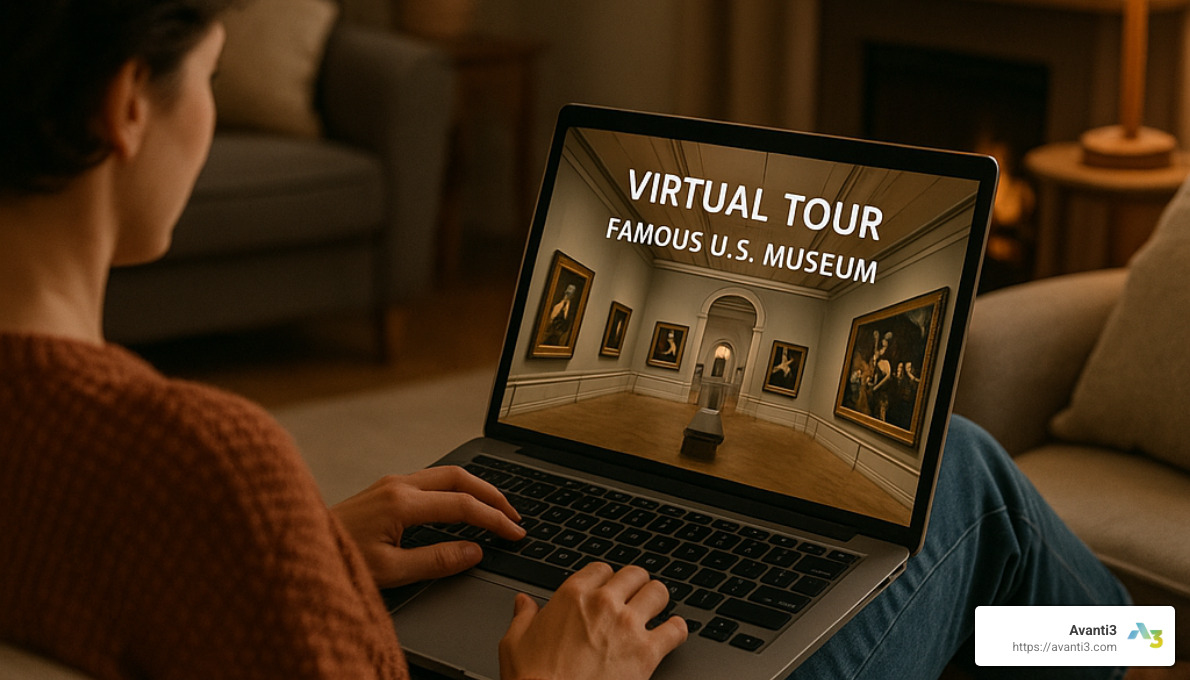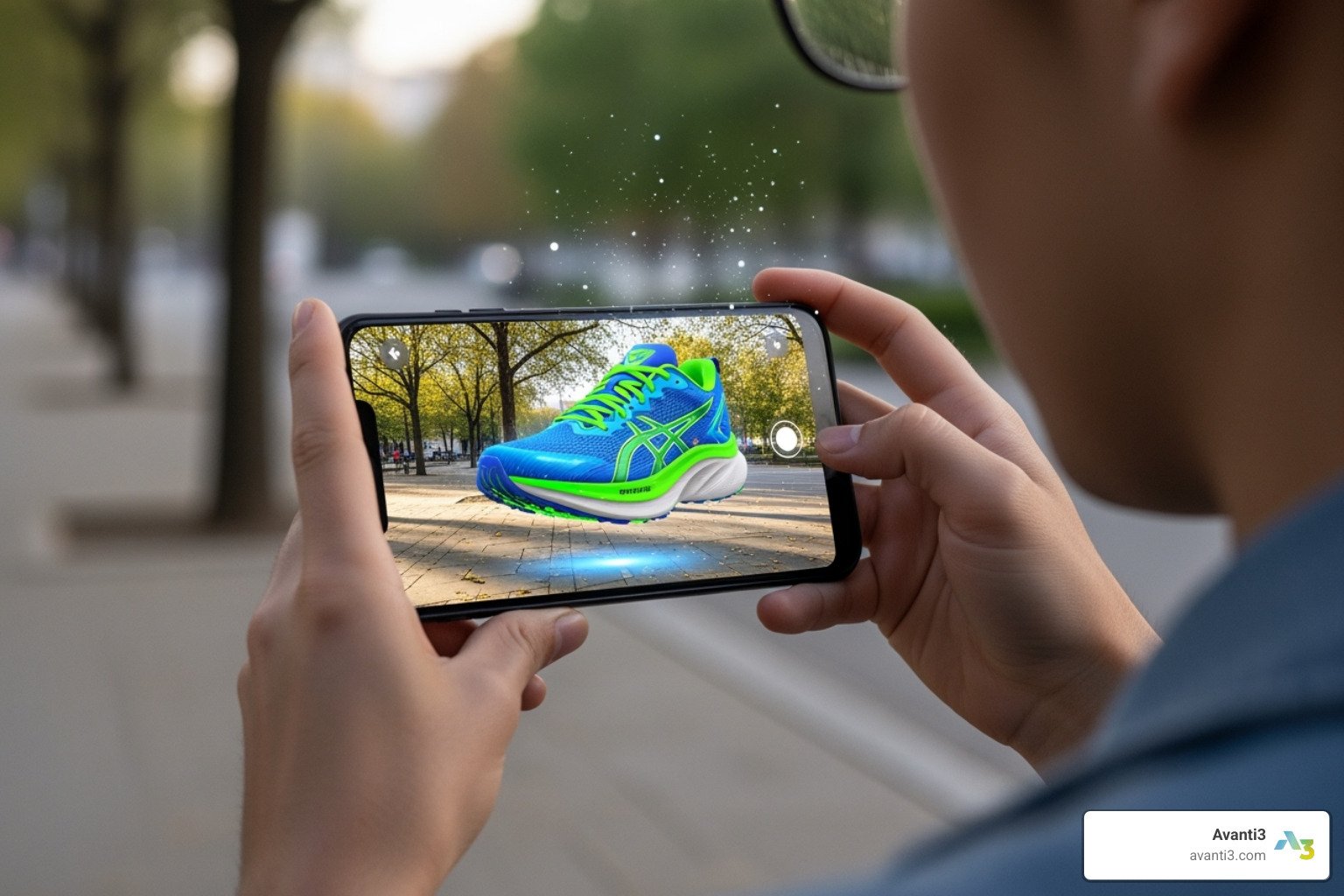virtual museum visit: 10 Best Free Tours to Explore in 2025
Experience World-Class Museums From Your Home
A virtual museum visit allows you to explore famous museums and galleries from anywhere with an internet connection. No tickets, travel, or time constraints required.
How to Visit Museums Virtually:
1. Use Google Arts & Culture (1,200+ museums available)
2. Visit museum websites directly for official virtual tours
3. Steer with mouse/trackpad (click arrows or drag to move)
4. Look for camera icons to zoom in on artifacts
5. Use fullscreen mode for the most immersive experience
The concept of virtual museum tours has revolutionized how we experience art and history. Gone are the days when exploring the British Museum’s Egyptian collection or admiring Van Gogh’s masterpieces required expensive plane tickets and accommodations. Today, institutions like the Louvre, Smithsonian, and Guggenheim offer comprehensive online experiences featuring 360-degree panoramas, high-resolution artwork details, and even guided audio tours.
Virtual museum visits became particularly essential during global lockdowns, but their convenience, accessibility, and educational value ensure their permanent place in our cultural landscape. Whether you’re researching for a school project, planning a future trip, or simply satisfying your curiosity about world heritage, these digital doorways to culture are invaluable resources.
As Samir ElKamouny from Avanti3, I’ve helped numerous organizations develop virtual museum visit platforms that blend technical excellence with user-friendly interfaces, ensuring cultural treasures remain accessible to everyone regardless of physical or geographical limitations.
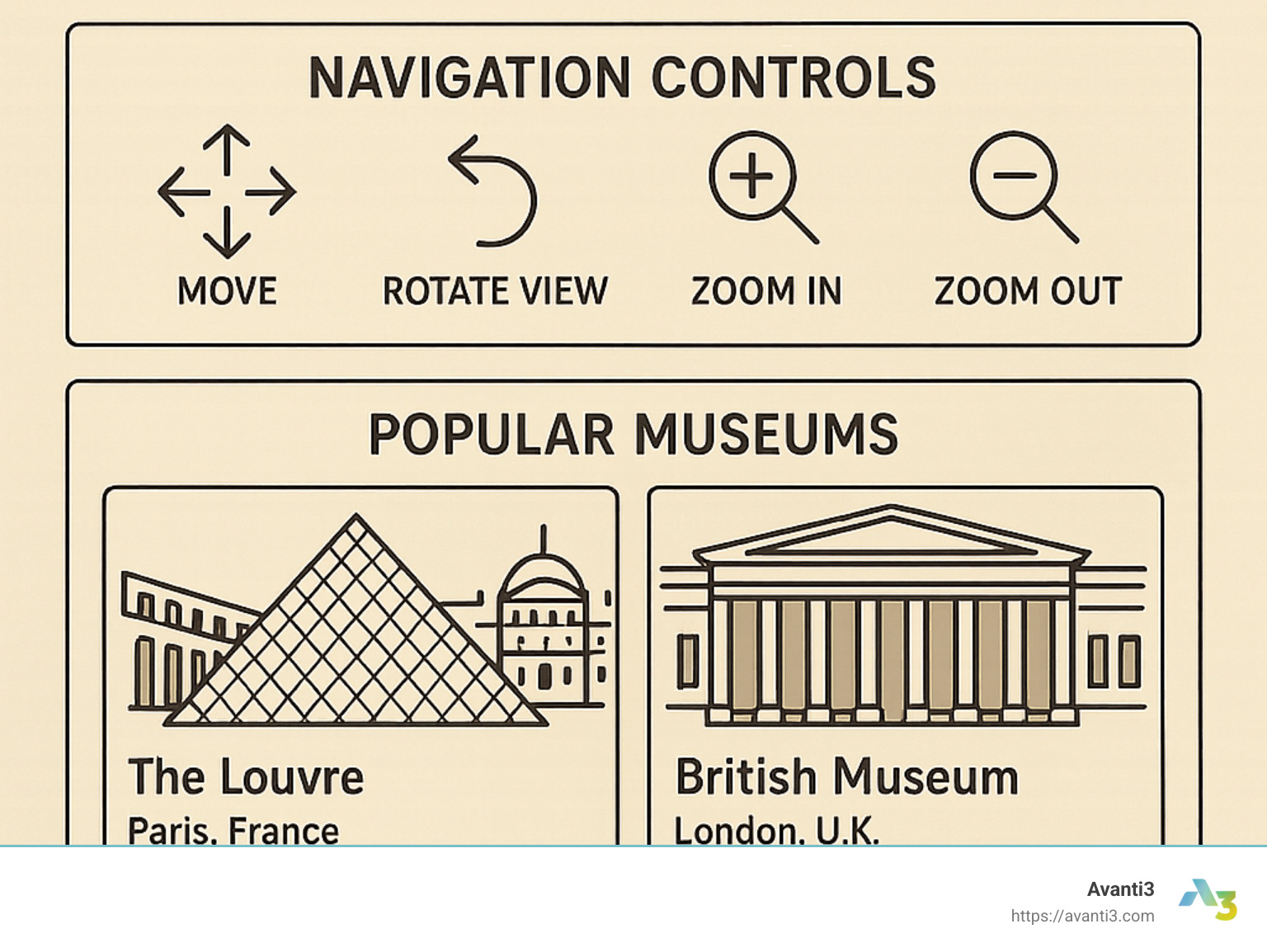
What Is a Virtual Museum Visit?
A virtual museum visit offers a digital window into the world’s greatest cultural institutions—right from your couch. It’s like having a magical portal where you can explore museums and galleries using just your computer, tablet, or smartphone. No need to book flights or stand in ticket lines!
These digital journeys come in several flavors, each offering unique ways to experience art and history. The most popular is the self-guided 360° tour, where you can look around in all directions and move between rooms as if you were actually there. It’s like having the whole museum to yourself!
Google Arts & Culture has become a treasure trove for art lovers, hosting thousands of high-resolution masterpieces with fascinating background information. For something more personal, many museums now offer live-streamed curator tours where expert guides walk you through exhibits in real-time, answering questions along the way.
For the tech-savvy explorer, some museums even offer avatar-based experiences where you control a digital mini-me to wander through virtual galleries, sometimes bumping into other visitors from around the world.
As the Smithsonian National Museum of Natural History perfectly puts it: “The virtual tours allow visitors to take self-guided, room-by-room tours of select exhibits and areas within the museum from their desktop or mobile device.”
How Does a Virtual Museum Visit Work?
Behind every virtual museum visit lies clever technology that brings these experiences to life. Museums typically create these digital twins using panoramic imaging—capturing complete 360-degree photos of each gallery space with specialized cameras.
For those “wow” moments when you find incredible details in famous artworks, thank gigapixel photography. These ultra-high-resolution images let you zoom in to see brushstrokes and details that might be hard to spot even in person. The Smithsonian captures panoramas “at 22,000 pixels on the long side”—that’s sharper than the human eye can see when standing in the actual gallery!
Navigation is usually intuitive—just click on floor arrows to move between rooms or use navigation maps to jump to specific galleries. Many tours include audio guides that automatically play when you enter certain spaces or click on featured artifacts, adding context to what you’re seeing.
While standard screens work perfectly well, some advanced tours support VR headsets for those wanting total immersion. Pop on a headset and suddenly you’re standing in the Louvre, with no one blocking your view of the Mona Lisa!
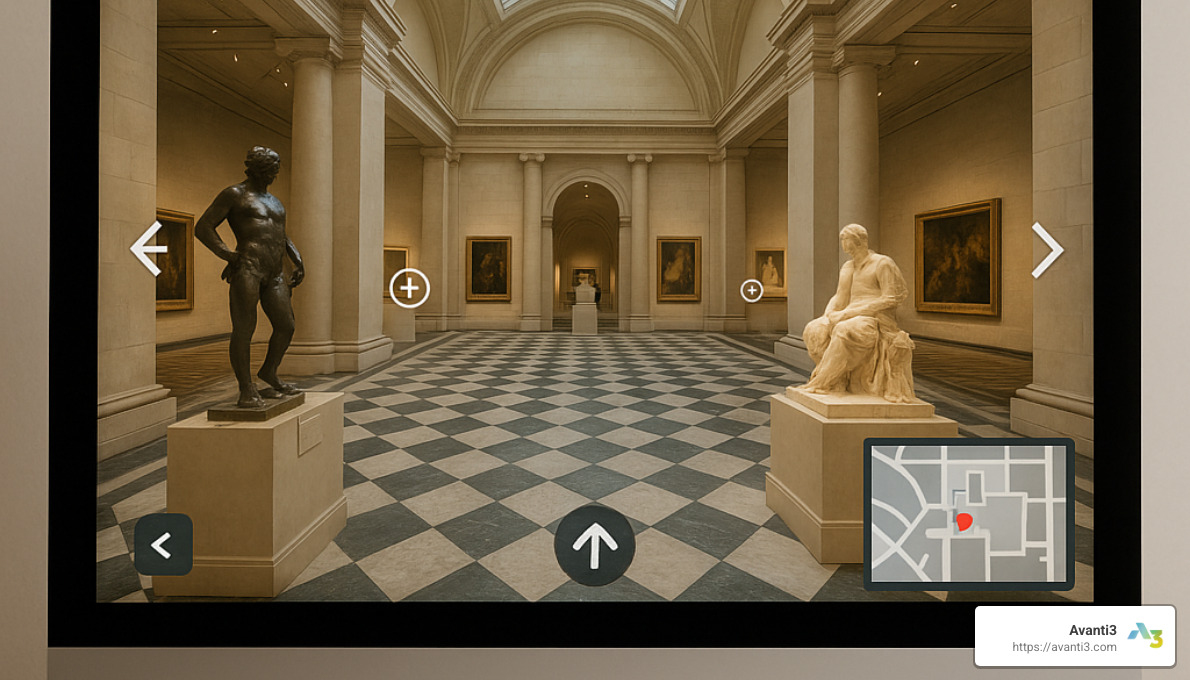
Technology Behind the Scenes
Creating a seamless virtual museum visit requires some serious technical wizardry happening behind the curtain.
When you’re rotating that ancient Greek vase to see every intricate detail, you’re likely interacting with a 3D model created through photogrammetry. This clever technique involves taking dozens of photos from different angles and stitching them together into a digital twin you can examine from any perspective.
Matterport cameras have revolutionized how museums create these virtual spaces. These futuristic devices capture both visual information and spatial measurements simultaneously, creating accurate 3D recreations that feel remarkably like the real thing.
The magic that makes everything run smoothly in your browser? That’s WebGL (Web Graphics Library), which powers interactive 3D and 2D graphics without requiring any special plugins or software downloads.
Many prestigious institutions like the Smithsonian rely on the krpano engine, a specialized JavaScript library that handles those massive panoramic images with buttery-smooth navigation. As they note, their tours are “hand-coded in HTML5 and JavaScript using the krpano graphics library.”
At Avanti3, we’re taking these technologies even further through our Digital Experience Design solutions. We’re blending traditional virtual tour elements with cutting-edge Web3 features that boost engagement and create new possibilities for museums to connect with audiences worldwide—changing passive viewers into active participants in cultural exploration.
7 Major Benefits of Visiting Museums Virtually
Feeling of wonder when you first stepped into a grand museum? That same magic is now available right from your couch, and it comes with some pretty amazing perks. Virtual museum visits have transformed how we experience cultural treasures, making them more accessible than ever before.
Accessibility for everyone is perhaps the most heartwarming benefit. Virtual tours tear down the physical barriers that might keep people with mobility challenges from experiencing museums. They also bring world-class collections to folks in remote villages who may never have the chance to travel to Paris or New York. A grandmother in rural Montana can now share the Louvre with her grandchildren, creating memories without leaving home.
The joy of cost-free learning can’t be overstated. While physical museum tickets can add up quickly for families (especially at prestigious institutions), their virtual counterparts typically cost nothing. The British Museum, Louvre, and hundreds of other cultural powerhouses offer their digital experiences free of charge, removing financial problems to cultural education for students, families, and curious minds everywhere.
Time flexibility means you can visit the Guggenheim at midnight in your pajamas if that’s when inspiration strikes. Unlike physical museums with set hours, virtual tours are always open, waiting patiently for your visit. Take as long as you want examining that Van Gogh brushstroke, or pause mid-tour to make lunch—the museum will be right where you left it.
The global reach of virtual museums might be my favorite benefit. Within minutes, you can transport yourself from ancient Egyptian artifacts at the British Museum to stunning Impressionist paintings at the Musée d’Orsay in Paris. This kind of cultural hopping would require days of travel and significant expense in the physical world, but happens at the click of a button online.
Planning a dream vacation? Virtual tours serve as the perfect preview for in-person trips. You can scout out must-see exhibits, get familiar with confusing museum layouts, and create your ideal itinerary before ever stepping on a plane. Many travelers find their actual visits more meaningful after first exploring virtually.
Many virtual museum experiences include thoughtful inclusive design features like detailed text descriptions, audio narration options, and keyboard navigation that make them usable by people with various disabilities. These features often provide context and detail that might be missed even during in-person visits.
In our increasingly climate-conscious world, the eco-friendly tourism aspect of virtual visits deserves special mention. By exploring digitally, you’re eliminating the carbon footprint associated with travel to museums, offering an environmentally mindful way to experience global culture.
As the Museum of the American Revolution beautifully puts it: “We welcome you to explore the Museum’s Virtual Museum Tour. Immerse yourself in the history of the nation’s founding through 360-degree panoramic images, high-resolution artifacts, and a guided audio tour.”
At Avanti3, we’re passionate about making these kinds of transformative digital experiences even more engaging through our innovative approaches to digital storytelling and interaction.
Essential Tech, Platforms & Navigation Tips
Ready to explore the world’s greatest museums from your sofa? Let’s walk through everything you need to know to make your virtual museum visit smooth and enjoyable.
Platforms and Interfaces
Google Arts & Culture stands as the superstar of virtual museum platforms. Think of it as your global museum pass – with over 1,200 museums and galleries at your fingertips. Their familiar Street View interface makes exploring intuitive, even if you’re not tech-savvy. Just click those blue arrows on the floor, and you’re off to the next gallery!
Many major museums have developed their own bespoke virtual experiences too. The Louvre, for instance, offers themed journeys like “The Advent of the Artist” directly through their website. These custom tours often highlight the museum’s unique personality and showcase their most treasured collections.
Navigating these virtual spaces is surprisingly intuitive once you know a few simple tricks. Look for those blue arrows on the floor – they’re your pathway through the exhibits. Want to look around? Just click and drag your mouse (or swipe if you’re on a tablet). Spotted something fascinating? Watch for camera icons that let you zoom in for incredible detail – often better than what you’d see in person! And don’t forget to enable fullscreen mode for the most immersive experience – it’s like stepping through your screen into the museum itself.
As the Smithsonian helpfully advises: “Click on blue arrow links on the floor or use the navigation map to move between rooms. Look for the camera icon to zoom in on objects or exhibit panels.”
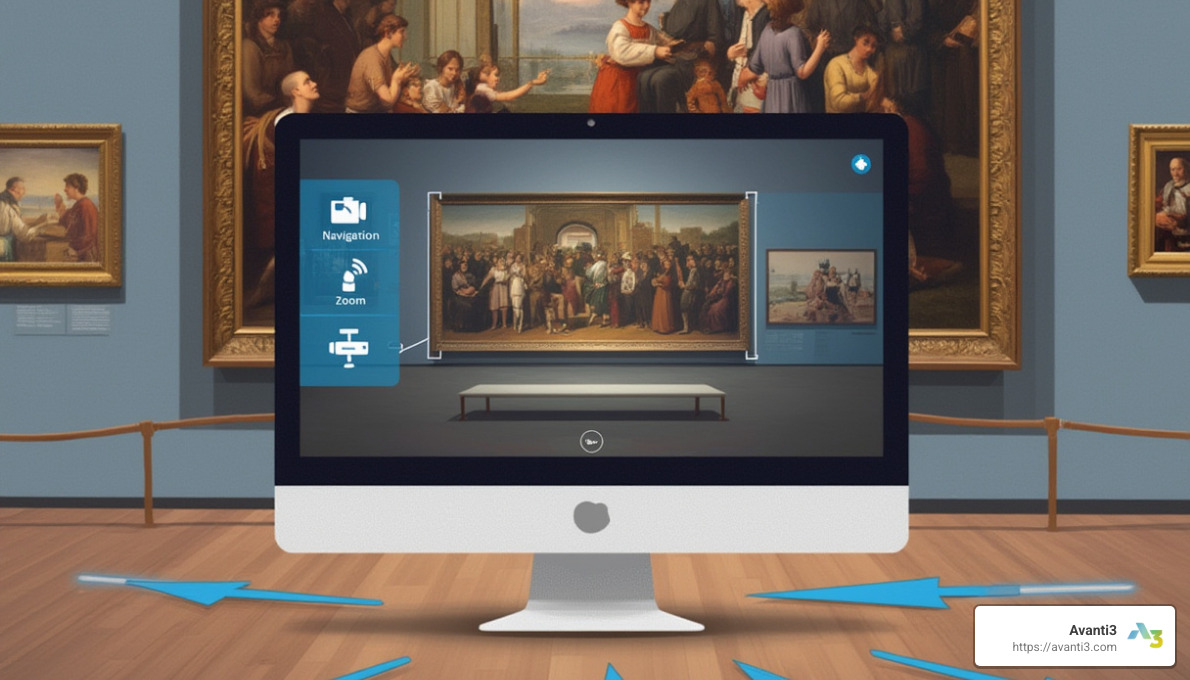
Devices & Accessibility for a Virtual Museum Visit
The beauty of virtual museum visits is their flexibility across devices, though your experience might vary depending on what you’re using.
Your trusty desktop computer typically delivers the premium experience. The larger screen showcases artwork in glorious detail, while greater processing power handles 360° environments smoothly. Most tours work best with modern browsers like Chrome, Firefox, or Edge.
On the go? Tablets and smartphones work for most tours, though navigating can be a bit trickier on smaller screens. Some advanced tours, like those from the Museum of AI, actually recommend against mobile viewing for the fullest experience.
For the truly adventurous, VR headsets take immersion to another level. Imagine standing face-to-face with the Mona Lisa in the Louvre’s special “Beyond the Glass” VR experience – without the usual crowds!
Virtual museums have made wonderful strides in accessibility. Many platforms offer screen reader compatibility, keyboard navigation for those who can’t use a mouse, closed captioning, and text alternatives for visual information. These thoughtful features open art and history to everyone, regardless of physical limitations.
One quick tip: if you’re using ad-blocking software, you might need to disable it for some virtual tours. As the Smithsonian notes, even though their tours don’t contain ads, blockers can sometimes restrict the JavaScript and XML that powers the navigation.
Interacting with Exhibits Online
Today’s virtual museum visits go far beyond passive viewing – they invite you to engage with history and art in fascinating ways.
Find clickable hotspots that reveal the stories behind the artifacts. These digital information cards often share fascinating details about an object’s creation, historical significance, or the painstaking conservation work that preserved it for future generations.
Many museums now offer 3D object rotation tools that let you examine treasures from every angle – sometimes providing views that would be impossible even for in-person visitors peering through display cases.
For families and educators, interactive quizzes make learning stick while keeping it fun. As the Museum of AI mentions, their virtual tour “includes interactive quizzes to celebrate learning.” Some museums have even created virtual scavenger hunts that challenge visitors to locate specific items throughout the galleries – perfect for school groups or family game nights.
At Avanti3, we’re taking these interactions to new heights through our Virtual Art Experiences that incorporate blockchain and NFT technology. These innovations create entirely new ways for visitors to collect, share, and even own digital representations of their favorite museum pieces – building a bridge between traditional cultural institutions and the exciting possibilities of Web3.
10 World-Class Museums Offering Free Online Tours
The digital revolution has thrown open the grand doors of the world’s most prestigious cultural institutions, inviting everyone with an internet connection to explore their treasures. These virtual museum visits offer windows into different civilizations, artistic movements, and human achievements—all without the need for plane tickets or entrance fees.
Each of these ten remarkable institutions has crafted unique online experiences that capture their distinctive character and collections. Whether you’re a history buff, art enthusiast, or simply curious about our shared cultural heritage, these virtual tours provide hours of fascinating exploration.
What makes these digital experiences special isn’t just the high-resolution images of famous artifacts—it’s the thoughtfully designed interfaces that let you wander through grand halls at your own pace, zoom in on intricate details you might miss in person, and access expert commentary that enriches your understanding.
Many of these museums have partnered with Google Arts & Culture, while others have developed proprietary platforms that showcase their collections in innovative ways. The best part? You can visit all ten in a single afternoon if you wish—something that would be physically impossible in the real world.
Let’s start on a global journey through these magnificent institutions, each offering a unique perspective on human creativity and history. From ancient Egyptian artifacts to contemporary Korean art installations, these virtual museum visits span continents and millennia, bringing the world’s cultural wealth directly to your screen.
At Avanti3, we’ve been inspired by these pioneering digital experiences as we develop next-generation virtual spaces that incorporate Web3 technologies. The museums featured here represent the current gold standard in virtual cultural experiences—the foundation upon which future innovations will build.
The British Museum, London
The British Museum’s virtual museum visit takes you through one of the world’s oldest public museums, home to over eight million works spanning human history. Their digital experience lets you marvel at the iconic Rosetta Stone up close, examining the ancient text that open uped the secrets of Egyptian hieroglyphics.
The virtual tour showcases the breathtaking Great Court, with its spectacular glass roof designed by Foster + Partners. This architectural wonder forms the heart of the museum and appears even more dramatic when viewed from the perfect angles offered in the digital experience.
The museum’s extensive Egyptian collection, including remarkably preserved mummies and elaborate sarcophagi, is particularly well-presented online. The high-resolution photography captures intricate details of ancient craftsmanship that are sometimes difficult to appreciate in person due to protective display cases.
What makes the British Museum’s virtual offering unique is their interactive “Story Map” feature, which organizes artifacts thematically rather than by physical location. This approach often creates more meaningful connections between items from different time periods and civilizations.
The Louvre, Paris
The Louvre’s virtual museum visit offers unprecedented access to one of the world’s most visited museums. Their “Mona Lisa VR” experience provides a rare opportunity to view Leonardo da Vinci’s masterpiece without the usual crowds, allowing you to appreciate subtle details like her enigmatic smile and the atmospheric perspective of the background landscape.
The “Advent of the Artist” virtual tour explores how artists began signing their works during the Renaissance, signaling a shift in how society viewed creative individuals. This themed approach offers context that improves appreciation of the works beyond their visual appeal.
Beyond the artwork, the Louvre’s online experience showcases the palace architecture itself—a magnificent building that began as a medieval fortress before evolving into the grand museum we know today. Virtual visitors can explore the ornate ceilings, grand staircases, and the iconic glass pyramid entrance designed by I.M. Pei.
Smithsonian National Museum of Natural History
The Smithsonian’s virtual museum visit is a technical marvel featuring over 22,000 high-resolution panoramic images. Their dinosaur hall is particularly impressive online, allowing visitors to walk among massive prehistoric skeletons, including the imposing Tyrannosaurus rex.
Navigation through this extensive museum uses an intuitive blue-arrow system that mimics natural walking paths. The Smithsonian has made their tour especially accessible, with keyboard controls and screen reader compatibility for visitors with disabilities.
What sets this virtual tour apart is its integration with scientific research. The museum provides links to published studies about many featured specimens, making it a valuable resource for students and educators. Their commitment to scientific accuracy is evident in the detailed information accompanying each exhibit.
As the museum explains on their virtual tour platform: “The virtual tours allow visitors to take self-guided, room-by-room tours of select exhibits and areas within the museum from their desktop or mobile device.” This comprehensive approach has made it a model for other institutions developing online experiences.
Guggenheim Museum, New York
The Guggenheim’s virtual museum visit showcases not only world-class modern art but also Frank Lloyd Wright’s spiral design—often considered a work of art itself. The online experience allows you to ascend the famous spiral ramp, viewing the building from angles that highlight its innovative architecture.
Using Google’s Street View technology, visitors can stroll through galleries featuring iconic works by Kandinsky, Picasso, and Pollock. The spiral layout creates a unique viewing experience both in person and online, with artworks appearing in a continuous sequence rather than in separate rooms.
The virtual tour includes high-resolution images of key pieces from the collection, with accompanying information that places each work in its art historical context. The Guggenheim’s commitment to education extends to their digital platform, making complex artistic movements accessible to visitors of all backgrounds.
Rijksmuseum, Amsterdam
The Rijksmuseum’s virtual museum visit brings Dutch Golden Age masterpieces to life through extraordinarily detailed photography. Their presentation of Rembrandt’s “Night Watch” allows online visitors to zoom in on brushstrokes and details invisible to the naked eye, revealing the master’s technique in unprecedented clarity.
The 360-degree galleries recreate the museum’s thoughtful arrangement of paintings, furniture, and decorative arts that tell the story of Dutch history and culture. Virtual visitors can appreciate how the museum contextualizes artworks within their historical period.
What makes the Rijksmuseum’s online experience special is their commitment to making their entire collection accessible digitally. Beyond the virtual tour, they’ve digitized over 700,000 objects with high-resolution photography and comprehensive information, creating one of the world’s most extensive online museum resources.
Van Gogh Museum, Amsterdam
The Van Gogh Museum’s virtual museum visit offers intimate access to over 200 paintings by the tortured genius, including “Sunflowers,” “The Bedroom,” and his haunting self-portraits. The online experience is organized chronologically, allowing visitors to trace the rapid evolution of Van Gogh’s distinctive style over his brief career.
What makes this virtual tour particularly moving is the inclusion of Van Gogh’s personal letters alongside his artwork. These writings provide insight into his thoughts, struggles, and artistic vision, creating a more complete understanding of the man behind the masterpieces.
The museum’s digital platform includes an immersive color study feature that analyzes Van Gogh’s bold palette choices and demonstrates how his use of complementary colors created vibrant, emotionally charged compositions. This technical analysis adds depth to the viewing experience that even in-person visitors might miss.
Musée d’Orsay, Paris
Housed in a former railway station, the Musée d’Orsay’s virtual museum visit showcases its unparalleled collection of Impressionist and Post-Impressionist masterpieces. The online experience captures the museum’s unique atmosphere, with natural light streaming through the original station clock windows illuminating works by Monet, Renoir, and Degas.
The virtual tour highlights the museum’s architectural features, including the magnificent Beaux-Arts main hall with its ornate ceiling and the famous giant clock face that offers views across Paris. These elements are integral to the museum experience and are beautifully captured in the digital platform.
The museum’s 19th-century sculpture collection appears particularly dramatic online, with virtual lighting that accentuates the three-dimensional qualities of works by Rodin and others. The photography skillfully conveys the texture and form of these sculptural masterpieces.
National Museum of Anthropology, Mexico City
The National Museum of Anthropology’s virtual museum visit offers a journey through Mexico’s rich pre-Columbian heritage. The online experience showcases spectacular Maya artifacts, including intricately carved stelae and the famous sunstone calendar, with detailed information about their cultural significance.
The virtual tour includes El Paraguas (“The Umbrella”), the museum’s iconic concrete courtyard feature that appears to float above a central fountain. This architectural marvel forms the heart of the physical museum and is beautifully captured in the digital experience.
With 22 exhibit rooms available online, visitors can explore the diversity of Mesoamerican civilizations, from the Olmec to the Aztec. The virtual platform maintains the museum’s educational mission by providing context for understanding how these ancient cultures developed and interacted.
National Museum of Modern & Contemporary Art, Seoul
The MMCA’s virtual museum visit offers a six-floor walkthrough of Korea’s premier contemporary art institution. The online experience showcases both Korean artists and international installations, providing insight into the dynamic global art scene with an Asian perspective.
What makes this virtual tour distinctive is its presentation of art that may be less familiar to Western audiences. It offers a valuable opportunity to find contemporary Korean artists whose work reflects both traditional influences and modern global conversations.
The museum’s dramatic architecture, with its combination of historical and modern elements, is effectively captured in the virtual experience. Visitors can appreciate how the physical space interacts with the artworks, creating meaningful juxtapositions between pieces.
Museum of the American Revolution, Philadelphia
The Museum of the American Revolution’s virtual museum visit brings to life the dramatic story of America’s founding through interactive exhibits and rare artifacts. The centerpiece is Washington’s War Tent—the canvas marquee that served as George Washington’s headquarters during the Revolutionary War.
The online experience is organized around four guiding questions that frame the American Revolution: How did people become Revolutionaries? How did the Revolution survive its darkest hour? How was the war? What kind of nation did the Revolution create?
High-resolution artifacts include personal items belonging to Revolutionary figures, weapons, and documents that shaped a nation. The museum explains: “We welcome you to explore the Museum’s Virtual Museum Tour. Immerse yourself in the history of the nation’s founding through 360-degree panoramic images, high-resolution artifacts, and a guided audio tour.”
The British Museum, London
Step into the hallowed halls of history without leaving your home. The British Museum’s virtual tour throws open the digital doors to one of humanity’s greatest treasure troves – a collection spanning an astonishing two million years of human history, art, and cultural achievement.
When you first enter the virtual space, you’re greeted by the breathtaking Great Court with its spectacular glass roof – the largest covered public square in Europe. Sunlight streams through the geometric patterns, creating an ever-changing dance of light across the white stone interior. This architectural marvel serves as your starting point for a journey through time and civilization.
The star attraction for many visitors is undoubtedly the Rosetta Stone, the key that open uped ancient Egyptian hieroglyphics. Through the virtual museum visit, you can examine this world-changing artifact in remarkable detail. The high-resolution imaging allows you to zoom in so close you can see the individual chisel marks – something that’s difficult even for in-person visitors standing behind the protective glass.
Egyptian history comes alive as you steer to the mummy galleries, where detailed information panels reveal the fascinating stories and rituals surrounding these ancient preserved remains. Each artifact carries its own narrative, from ornate sarcophagi to delicate funerary items that accompanied the deceased on their journey to the afterlife.
What makes this virtual experience particularly special is the museum’s clever integration of Google Street View technology with their extensive collection database. This means you’re not just looking at pretty pictures – you’re navigating the actual physical space while having instant access to scholarly information about specific artifacts that catch your eye.
The interactive timeline feature adds another dimension to your virtual museum visit, placing objects in their proper historical context. This helps visitors understand how artifacts from different civilizations relate to each other chronologically, creating a more coherent picture of human development across continents and millennia.
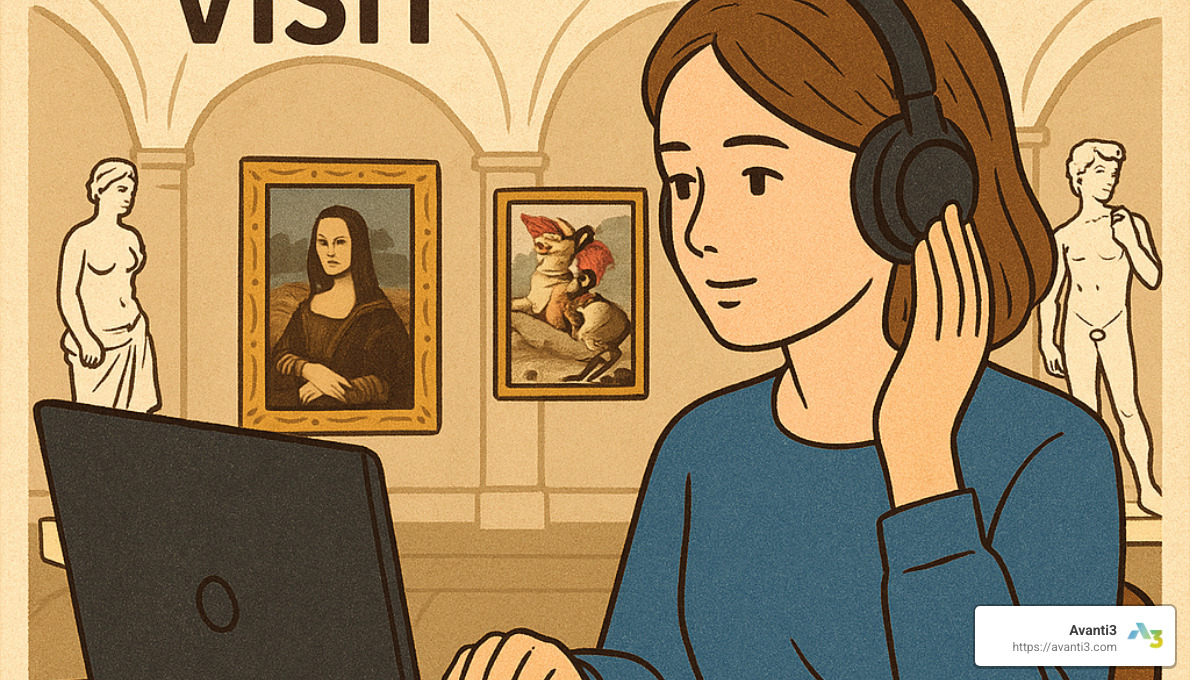
The British Museum’s virtual experience transforms what could be an overwhelming collection into an accessible, educational journey that you can take at your own pace. Whether you’re a history buff, a student working on a research project, or simply curious about human heritage, this digital doorway to our collective past offers endless opportunities for findy and wonder.
The Louvre, Paris
The Louvre – a name that instantly conjures images of artistic masterpieces and French grandeur – offers several themed virtual museum visits that bring its treasures to your screen no matter where you are in the world.
When you digitally step into this former royal palace, you’ll find curated experiences that go beyond simply showing art. The “Advent of the Artist” tour takes you on a fascinating journey through time, revealing how anonymous medieval craftsmen evolved into the celebrated individual artists of the Renaissance. You’ll witness this change through carefully selected works that highlight this pivotal shift in artistic identity.
For those interested in the intersection of power and creativity, the “Power Plays” virtual tour examines how art has long been a tool of political influence. From royal portraits to imagery, this exploration reveals how rulers and nations have used visual art to shape public perception throughout history.
The palace itself is an architectural masterpiece worthy of exploration. The virtual tour lets you admire the ornate ceilings, grand staircases, and the stunning glass pyramid entrance that has become an iconic symbol of Paris. As the Louvre itself invites: “Visit the museum rooms and galleries, admire the palace architecture and enjoy the views!”
Perhaps most exciting for art enthusiasts is the specialized VR experience centered on the world’s most famous painting. “Mona Lisa: Beyond the Glass” allows you to get closer to da Vinci’s masterpiece than physical visitors ever could, revealing brush strokes and details typically hidden behind protective glass and crowds of tourists.
Rather than simply recreating a walking tour, the Louvre’s digital approach focuses on thematic storytelling that provides context and deeper understanding of the artworks. This makes the virtual museum visit not just a substitute for being there, but a unique educational experience in its own right.
Smithsonian National Museum of Natural History
When it comes to technical excellence in virtual museum visits, the Smithsonian’s Natural History Museum tour truly stands out from the crowd. It’s like having a private, after-hours pass to one of America’s most beloved museums—minus the crowds and sore feet!
The Smithsonian team has created something special here, capturing the museum in breathtaking detail using professional Nikon DSLR cameras to create panoramic images that are a staggering 22,000 pixels on the long side. These aren’t just quick snapshots—they’re carefully crafted windows into the museum’s world.
Key Features:
– Incredibly detailed panoramas that let you zoom in to examine specimens almost as closely as in person
– Complete access to all permanent exhibits, with the dinosaur hall being a particular highlight for visitors of all ages
– Special behind-the-scenes peeks into research areas normally off-limits to the public
– User-friendly navigation with blue floor arrows and an interactive map that prevents getting “digitally lost”
What makes this virtual museum visit particularly impressive is the care taken with the technical implementation. The entire experience is hand-coded in HTML5 and JavaScript using the krpano graphics library, creating a smooth, responsive tour that works beautifully across devices.
The blue navigation arrows become your digital footsteps through the halls, allowing you to wander from the African elephants in the rotunda to the sparkling Hope Diamond, all with a few simple clicks. The interactive map keeps you oriented, something many virtual tours overlook.
For science teachers, students, or anyone fascinated by natural history, this virtual museum experience offers hours of exploration and learning. You can visit and revisit the halls at your leisure, taking as much time as you want with each exhibit—something that’s not always possible during a rushed in-person visit.
The scientific value here is exceptional, with the gigapixel imaging allowing researchers and curious minds alike to study specimens in remarkable detail from anywhere in the world. It’s a perfect example of how digital technology can make museum collections more accessible while preserving their educational impact.
Guggenheim Museum, New York
Step into the architectural marvel that is the Solomon R. Guggenheim Museum through their captivating virtual museum visit experience. What makes this digital tour truly special is how it captures both Frank Lloyd Wright’s building design and the museum’s impressive collection of modern and contemporary art.
The moment you enter the virtual space, you’re greeted by the museum’s iconic spiral design—a continuous ramp that gently curves upward for a quarter of a mile, creating one of the most distinctive gallery spaces in the world. As you steer through this virtual journey, you can almost feel the building’s organic flow that Wright intended to mimic the natural world.
Key Features:
– Experience the famous spiral ramp through intuitive Street View navigation
– Gaze upward at the spectacular glass dome skylight from various vantage points
– Explore exhibitions as they unfold along the continuous circular path
– Examine high-resolution artworks that pop against the museum’s minimalist white walls
The Google Arts & Culture platform perfectly captures this unique space, noting: “Steer the Guggenheim’s famous spiral staircase via Google Street View.” Unlike traditional museums with separate rooms, the Guggenheim’s spiral design creates a natural narrative flow that translates beautifully to the digital field.
What’s particularly delightful about touring the Guggenheim virtually is finding how the building itself frames each artwork. The gentle curve of the walls, the changing natural light from the skylight, and the open rotunda create different perspectives as you move through the space—elements you can appreciate from the comfort of your home.
The Guggenheim’s virtual experience demonstrates how thoughtful architecture and digital technology can combine to create an engaging online art experience that honors both the container and its contents.
Rijksmuseum, Amsterdam
Step into the magnificent halls of the Netherlands’ most celebrated museum without leaving your home. The Rijksmuseum’s virtual museum visit offers an intimate journey through Dutch cultural heritage that rivals the in-person experience in many ways.
The digital doorways of this Amsterdam treasure house swing open to reveal the breathtaking grandeur of recently renovated galleries, where natural light streams through historic windows to illuminate centuries of masterpieces. As you steer through the virtual space, you’ll find yourself surrounded by the genius of the Dutch Golden Age, with Rembrandt, Vermeer, and Frans Hals as your silent companions.
The Night Watch experience stands as the crown jewel of this virtual tour. The museum’s painstaking digitization allows you to examine Rembrandt’s brushstrokes with a level of detail that even in-person visitors rarely achieve. Zoom in to find hidden figures, subtle color transitions, and even the artist’s corrections – a truly intimate encounter with genius.
The 360-degree gallery views recreate the spatial experience of standing in these grand rooms, allowing you to look up at ornate ceilings, around at neighboring artworks, and even back at the pathways you’ve traveled. This immersive approach helps maintain the context that makes museum visits so meaningful.
While the physical museum can display only about 8,000 objects from its collection of over one million items (as Google Arts & Culture points out), the virtual experience offers a carefully curated journey through Dutch art history. The chronological navigation helps you understand how artistic styles evolved alongside the nation’s rising global influence during the 17th century.
What makes this virtual museum visit particularly special is how it captures the Rijksmuseum’s unique atmosphere – the blend of historic architecture with modern exhibition design, creating spaces that feel both timeless and contemporary. Even through your screen, you can sense the reverence these halls inspire in visitors from around the world.
Van Gogh Museum, Amsterdam
Step into the vivid world of one of history’s most celebrated artists through the Van Gogh Museum’s immersive virtual museum visit.
Unlike typical museum experiences that showcase diverse collections, this digital journey focuses entirely on Vincent van Gogh’s artistic legacy, offering an intimate look at his creative evolution and personal story. The virtual tour presents over 200 paintings in stunning high resolution, allowing you to examine every swirling brushstroke and bold color choice from the comfort of your home.
What makes this experience particularly special is the unprecedented access to Van Gogh’s complete artistic journey. You can trace his development from his early, darker Dutch period through to his vibrant French years, seeing how his technique and color palette transformed over time. Art students and enthusiasts particularly appreciate the ability to zoom in on details that would be impossible to study so closely in person due to security barriers and preservation concerns.
Beyond the paintings themselves, the virtual tour opens doors to Van Gogh’s inner world through his personal correspondence. You can browse through 750 letters that reveal the artist’s thoughts, struggles, and inspirations in his own words. These writings provide touching context for the works you’re viewing, creating a more emotionally connected experience.
The museum’s digital experience also includes fascinating color studies that break down Van Gogh’s use of complementary colors and bold palettes. These analytical features transform casual browsing into an educational opportunity that deepens your appreciation of his artistic innovations.
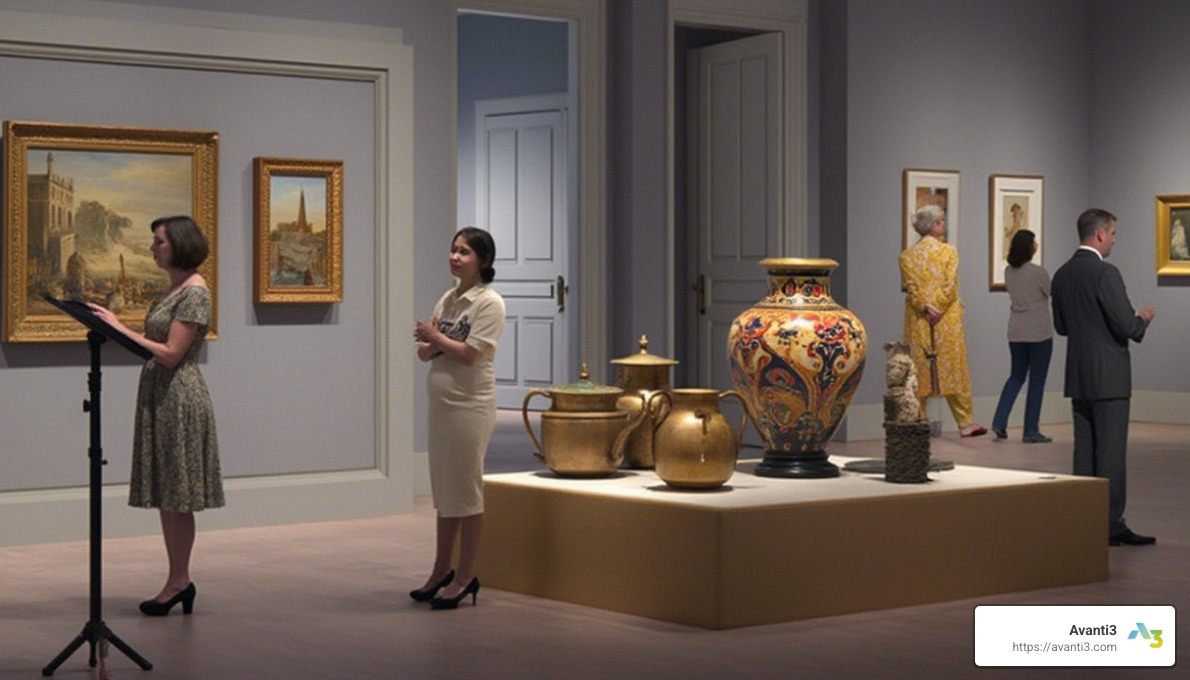
The chronological organization of the collection creates a natural narrative flow, allowing you to witness how Van Gogh’s distinctive style emerged and evolved throughout his brief but prolific career. This timeline approach makes the virtual museum visit more engaging than simply browsing through isolated masterpieces—it tells the complete story of an artist whose work continues to resonate with millions worldwide.
Whether you’re researching for academic purposes or simply seeking inspiration from one of history’s most passionate creators, the Van Gogh Museum’s virtual experience offers a depth of access that rivals—and in some ways surpasses—what you might experience in person in Amsterdam.
Musée d’Orsay, Paris
Step inside the magnificent former railway station that now houses one of the world’s most beloved art collections through a virtual museum visit to the Musée d’Orsay. The stunning Beaux-Arts architecture of this Parisian landmark is almost as famous as the masterpieces it contains.
As you steer the virtual galleries, you’ll be treated to breathtaking 360-degree views that capture both the grandeur of the space and the intimate details of the artwork. The soaring ceilings, ornate decorations, and that magnificent giant clock window (a favorite photo spot for in-person visitors) are all beautifully preserved in digital form.
The museum’s world-renowned collection of Impressionist and Post-Impressionist paintings takes center stage in this virtual experience. Get closer than you might even manage in person to examine the brushstrokes of Monet’s water lilies, the vibrant colors of Renoir’s dancing couples, the unique perspectives in Degas’ ballet scenes, and the emotional intensity of Van Gogh’s later works.
What makes this virtual museum visit particularly special is how it captures the interplay between art and architecture. As Google Arts & Culture notes, the “impressive art-nouveau” structure itself improves the viewing experience. The virtual tour thoughtfully includes the 19th-century sculptures that line the central hall, allowing you to appreciate how these three-dimensional works interact with the space around them.
The quality of the imaging lets you zoom in to see details that might escape notice during an in-person visit, especially in the more popular galleries where crowds can make lingering difficult. Take your time to explore each room at your own pace, without the pressure of other visitors or closing times to hurry you along.
National Museum of Anthropology, Mexico City
This museum offers a fascinating virtual museum visit focused on Mexico’s pre-Hispanic heritage and indigenous cultures.
Key Features:
– 22 exhibit rooms covering different cultural regions and time periods
– 360-degree views of the iconic central courtyard with its “umbrella” fountain (el paraguas)
– Detailed examination of major artifacts including the Aztec Sun Stone
– Virtual access to large-scale architectural models and recreations
The museum’s virtual tour is particularly valuable for those interested in Mesoamerican cultures, as it houses the world’s largest collection of ancient Mexican art and ethnographic exhibits about Mexico’s indigenous peoples.
National Museum of Modern & Contemporary Art, Seoul
Step into the vibrant world of Korean contemporary art through the virtual museum visit of Seoul’s National Museum of Modern & Contemporary Art. This digital experience feels like having a personal art guide in one of Asia’s most dynamic cultural hubs.
As you steer through the six-floor virtual walkthrough, you’ll find artistic movements that might be entirely new to you. The museum presents a thoughtful chronological arrangement that tells the story of modern Korean art’s evolution – from its traditional roots to its cutting-edge present.
What makes this virtual tour particularly special is the access to high-resolution images of contemporary Korean artworks that rarely travel outside Asia. You can get incredibly close to brushstrokes and textures that would normally require a lengthy flight to experience in person.
The 360-degree views of large-scale installations and sculptures are especially impressive. These immersive spaces allow you to appreciate how the artworks interact with their environment, something that flat photographs simply can’t capture.
I found myself lingering in several galleries, captivated by pieces that challenge Western-centric art narratives. This virtual museum visit effectively addresses the underrepresentation of Korean art in typical art history education, offering a more global perspective on contemporary artistic movements.
Whether you’re an art enthusiast seeking to broaden your horizons or simply curious about creative expressions from another culture, the National Museum of Modern & Contemporary Art’s virtual tour provides an accessible gateway to Korea’s rich artistic landscape – no passport required.
Museum of the American Revolution, Philadelphia
This newer museum offers a particularly well-designed virtual museum visit organized around key historical questions.
Key Features:
– Four thematic “guiding questions” that structure the virtual exploration
– High-resolution artifacts with detailed contextual information
– 360-degree panoramic gallery images with navigation hotspots
– Immersive film experience featuring Washington’s War Tent
The museum explains that their virtual tour is “structured around four thematic guiding questions to frame visitor exploration,” creating a more narrative-driven experience than many other virtual tours. These questions include “How did people become Revolutionaries?” and “What kind of nation did the Revolution create?”
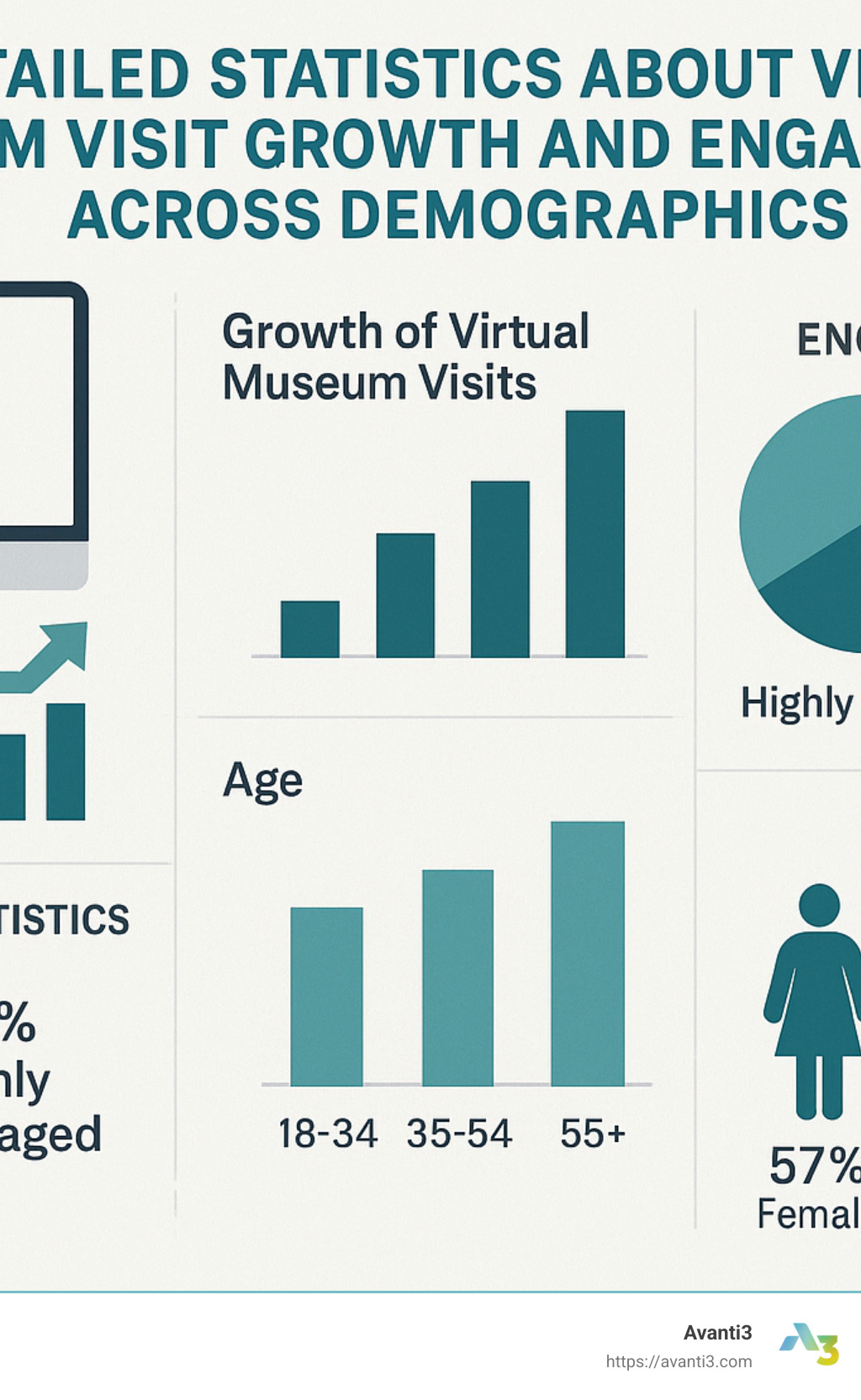
Educational Uses & Inspiring Future In-Person Trips
The magic of virtual museum visits extends far beyond casual browsing—they’ve revolutionized how we learn and plan our real-world trips.
For Educators and Students
Teachers have acceptd virtual museum tours as budget-friendly field trips that overcome traditional barriers like distance, cost, and scheduling challenges. A classroom in rural Kansas can explore the Louvre in the morning and the British Museum after lunch—all without permission slips or bus rentals.
“We used to visit one museum per year,” shares a middle school history teacher. “Now my students virtually explore dozens, and they’re connecting artistic movements across continents in ways I never expected.”
The flipped classroom approach pairs beautifully with these digital experiences. Students explore exhibits independently at home, freeing up class time for deeper discussions and activities. The Museum of the American Revolution brilliantly supports this teaching style by structuring their virtual tour around four thought-provoking questions that spark critical thinking and classroom debate.
Many institutions go the extra mile for educators, with the Smithsonian offering comprehensive lesson plans, activity sheets, and discussion guides that seamlessly integrate their virtual collections into existing curricula. These resources transform passive viewing into active learning experiences that stick with students long after the screen goes dark.
For Families and Travel Planners
Family game night gets a cultural upgrade when parents transform virtual museum visits into engaging scavenger hunts. “Find a painting with a dog” or “Locate three artifacts from ancient Egypt” turns art appreciation into a friendly competition that children actually request to play again.
For travel planning, virtual tours serve as perfect previews that help families make informed decisions. Parents can gauge their children’s interest in specific collections, estimate how much time to allocate for each museum, and identify must-see exhibits before booking a single ticket.
Interestingly, rather than replacing physical visits, these virtual experiences often inspire them. After exploring the Van Gogh Museum online, many visitors develop a deeper appreciation for the artist’s brushwork and feel compelled to see the real paintings in person. The virtual tour becomes the appetizer that creates hunger for the main course.
At Avanti3, we’re taking these educational journeys even further through our AR/VR Immersive Experiences. By blending virtual exploration with interactive elements like 3D artifact manipulation and gamified learning challenges, we create memorable moments that spark both immediate curiosity and future travel plans. Our school programs have shown that students who engage with museums virtually are significantly more likely to request family visits to those same institutions.
The beauty of virtual museum visits lies in their ability to remove barriers—whether geographic, financial, or physical—while simultaneously building bridges to real-world experiences that might otherwise never happen.
Limitations & Future of Virtual Museum Technology
Let’s be honest – while virtual museum visits open incredible doors to global culture, they’re not quite the same as being there in person. As amazing as technology has become, there are still a few problems to overcome.
Current Limitations
The most noticeable gap is probably the sensory experience. There’s something magical about standing before Monet’s water lilies or gazing up at a towering dinosaur skeleton that just doesn’t translate through a screen. The hushed sounds of visitors moving through galleries, the sense of scale, and those tiny details of texture and brushwork that make art come alive – these elements remain elusive in the digital field.
Not everyone has lightning-fast internet, either. Those gorgeous high-resolution panoramas and 3D models that make virtual tours so impressive? They require serious bandwidth. This creates an unfortunate barrier for people with slower connections or limited data plans, especially in rural or developing areas.
Copyright complexities also throw a wrench into the works. Museums often can’t display their entire collections online because of rights agreements, particularly with contemporary works. This means you might miss some treasures that are only available to in-person visitors.
Perhaps most significantly, the social magic of museums gets lost online. Those spontaneous conversations with strangers admiring the same painting, the shared gasps of wonder when turning a corner to find something unexpected, or the knowledgeable docent who shares a fascinating story about an artifact – these human connections are hard to replicate virtually.
The Future of Virtual Museum Technology
Despite these challenges, the future looks incredibly bright as several technologies begin to converge in exciting ways.
Metaverse museums are starting to emerge, creating persistent digital spaces where you can explore as an avatar alongside friends or other visitors from around the world. These spaces blend gaming elements with cultural education, making learning feel more like play and less like a lecture.
Blockchain technology is opening new possibilities for museum funding and engagement. At Avanti3, we’re pioneering ways for museums to create limited digital editions of their collections as NFTs, generating fresh revenue streams while expanding access to cultural treasures.
Augmented reality overlays will increasingly bring museum content into your personal space. Imagine examining a life-sized Egyptian sarcophagus in your living room or seeing how a Renaissance painting would look on your wall before ordering a print. These technologies create a middle ground between fully virtual and in-person experiences.
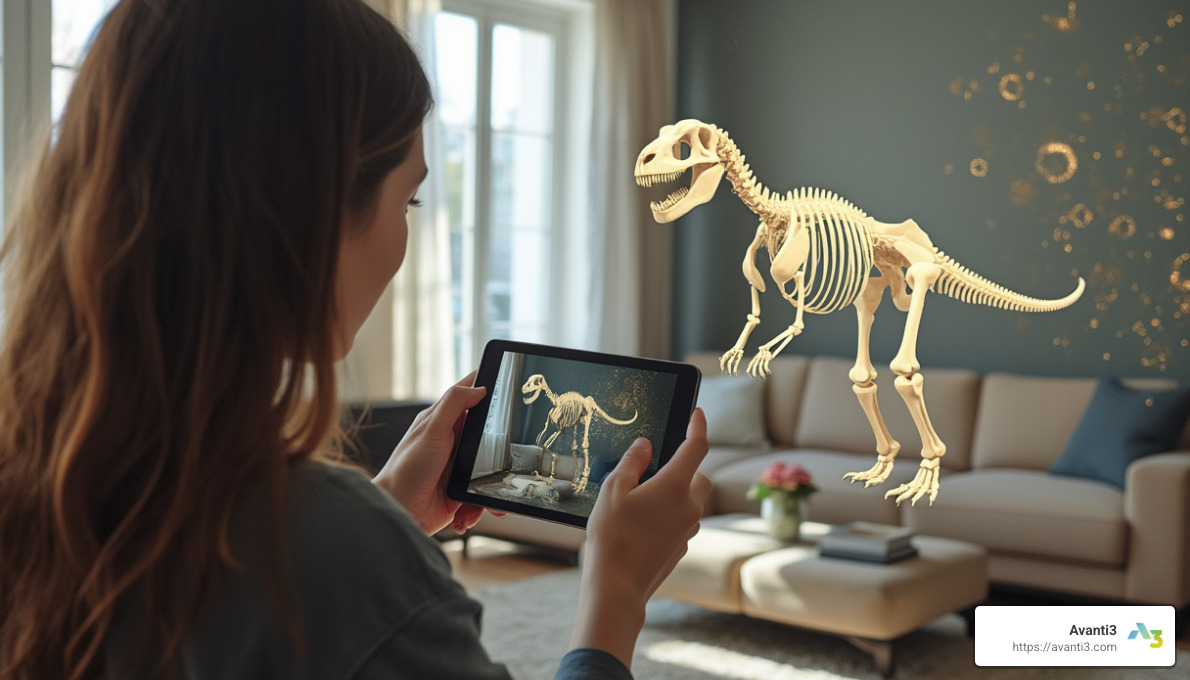
The development of haptic feedback devices may eventually allow you to “feel” the textured surfaces of sculptures and artifacts, adding that crucial sensory dimension currently missing from virtual tours. Imagine running your fingers over the contours of Rodin’s “The Thinker” or feeling the intricate carvings on an ancient mask – all from your home.
AI-powered personalized guides will likely replace generic audio tours, creating experiences custom to your interests, knowledge level, and previous museum interactions. Rather than a one-size-fits-all approach, these guides will adapt in real-time, diving deeper into topics that captivate you while skimming over others.
As these technologies mature, the line between physical and virtual museum experiences continues to blur. We’re moving toward hybrid models that combine the best of both worlds – the accessibility and technological marvels of virtual visits with elements that capture the sensory and social richness of being there in person.
Frequently Asked Questions about Virtual Museum Visits
What equipment do I need for a smooth virtual museum visit?
Wondering what you’ll need to start exploring museums from your couch? The good news is that a virtual museum visit doesn’t require fancy equipment for most experiences.
At the basic level, you just need your everyday devices – a computer, tablet, or smartphone will work perfectly fine. You’ll want a stable internet connection (broadband is best, especially for those gorgeous high-resolution images), and a modern web browser like Chrome, Firefox, Edge, or Safari.
If you’re looking to improve your experience, consider using a larger screen or monitor – it really makes a difference when examining the intricate details of a Van Gogh painting or ancient artifact. Some museums now offer VR-compatible tours, so if you happen to have a VR headset, you might enjoy an even more immersive experience. And don’t forget a decent pair of headphones to fully appreciate those audio guides and ambient sounds!
As the Smithsonian National Museum of Natural History suggests: “Use a desktop computer with a Chromium browser for optimal performance,” though I’ve found most tours work beautifully across various devices.
Are virtual tours really free?
Yes, most virtual museum visits are completely free! It’s quite remarkable that institutions like the Louvre, British Museum, and Smithsonian offer their digital experiences at no cost as part of their educational and community outreach missions.
That said, you might occasionally encounter specialized experiences that come with a small fee. These typically include live curator-led virtual tours or special exhibitions featuring exclusive content. Think of these as the digital equivalent of a special exhibition ticket at a physical museum.
Many museums include unobtrusive donation options within their virtual tours. If you enjoy your experience, consider contributing what you can. These donations help fund both digital initiatives and the physical preservation work that keeps these cultural treasures available for future generations. It’s a wonderful way to say “thank you” for the free access you’ve enjoyed.
How long should I allocate for a complete virtual museum visit?
One of the joys of a virtual museum visit is flexibility with time—no closing hours, no rush to see everything before your feet start aching!
How long you’ll need varies widely depending on the museum and your personal exploration style. A quick highlights tour of a museum might take just 15-30 minutes if you’re browsing casually. For a more thorough exploration of a major institution like the British Museum or the Louvre, you might want to set aside 2-3 hours to really appreciate the collections. Art and history enthusiasts who love reading every exhibit description might prefer spreading their visit across multiple sessions.
The beauty of virtual tours is that museum fatigue (that brain-and-feet exhaustion that hits around hour two of a physical visit) isn’t an issue. You can pause anytime, grab a coffee, and come back exactly where you left off—even days later.
I particularly like how the Museum of the American Revolution structures its tour around four thematic questions, making it natural to divide your exploration into meaningful chunks that you can enjoy at your own pace.
Conclusion
The explosion of virtual museum visits has thrown open the doors to cultural treasures in ways we couldn’t have imagined just a decade ago. This digital revolution represents one of the most profound democratizations of cultural access in our lifetime – what once required expensive plane tickets, hotel bookings, and admission fees is now available to anyone with an internet connection.
This shift doesn’t make physical museums any less magical or important. In fact, it’s quite the opposite. Virtual tours complement in-person experiences by preparing visitors for more meaningful physical visits. There’s something special about standing before the Mona Lisa after having explored her details virtually, or walking into the British Museum’s Great Court when you’ve already familiarized yourself with its layout online.
Digital access extends the reach of cultural institutions far beyond their physical walls. A student in rural Thailand can now explore the Smithsonian’s dinosaur hall, while an elderly person with mobility challenges in Arizona can wander through the Louvre’s galleries from their living room. These experiences create connections to our shared human heritage that were simply impossible before.
There’s also a preservation aspect that’s easy to overlook. Today’s virtual tours create detailed digital records of exhibitions and artifacts, capturing them at a specific moment in time. Future generations will have access to these digital time capsules, offering fascinating glimpses into how museums presented their collections in our era.
At Avanti3, we’re passionate about pushing these possibilities even further. Through our AR/VR Immersive Experiences, we’re helping museums and cultural institutions craft digital journeys that aren’t merely shadows of physical visits, but engaging, meaningful experiences in their own right.
The future of museum-going will likely blend physical and virtual elements in increasingly seamless ways. Imagine using AR glasses during your museum visit to see a Roman statue as it originally appeared with vibrant paint colors, or continuing to explore collections virtually after returning home from your trip. Your virtual preview might help you plan which galleries to prioritize during a time-limited visit, while your souvenir purchase might open up exclusive digital content that deepens your connection to what you’ve seen.
Despite all this technological innovation, the fundamental mission remains unchanged from when museums first opened their doors to the public: to share human knowledge, creativity, and heritage as widely as possible. Virtual museum visits simply give us powerful new tools to fulfill this timeless purpose, breaking down barriers of distance, ability, and economic means that have limited access for far too long.
As we continue developing these technologies, the goal isn’t to replace physical museums but to ensure that the wonders they contain can touch more lives, spark more curiosity, and inspire more learning than ever before. That’s a future worth building, one virtual tour at a time.

